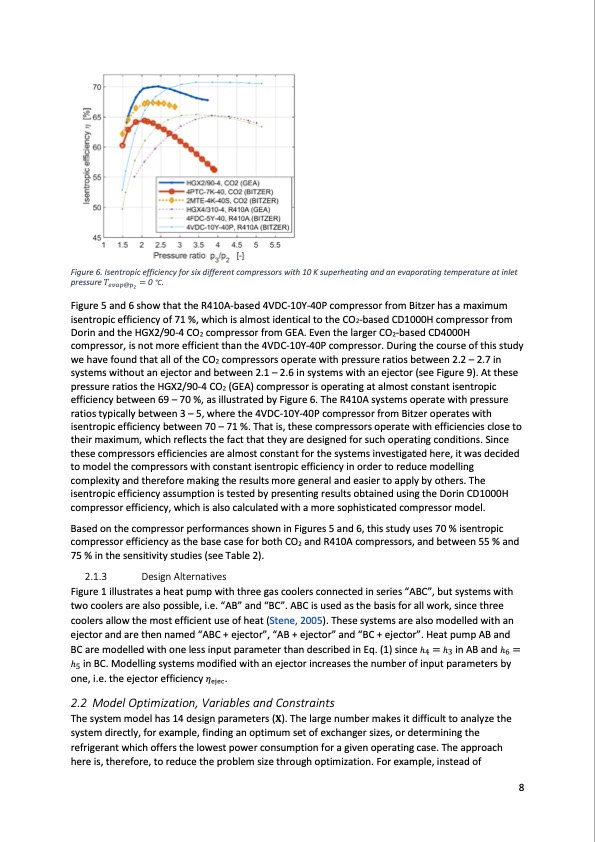
PDF Publication Title:
Text from PDF Page: 008
Figure 6. Isentropic efficiency for six different compressors with 10 K superheating and an evaporating temperature at inlet pressure 𝑇𝑇 = 0 °C. Figure 5 and 6 show that the R410A-based 4VDC-10Y-40P compressor from Bitzer has a maximum isentropic efficiency of 71 %, which is almost identical to the CO2-based CD1000H compressor from Dorin and the HGX2/90-4 CO2 compressor from GEA. Even the larger CO2-based CD4000H compressor, is not more efficient than the 4VDC-10Y-40P compressor. During the course of this study we have found that all of the CO2 compressors operate with pressure ratios between 2.2 – 2.7 in systems without an ejector and between 2.1 – 2.6 in systems with an ejector (see Figure 9). At these pressure ratios the HGX2/90-4 CO2 (GEA) compressor is operating at almost constant isentropic efficiency between 69 – 70 %, as illustrated by Figure 6. The R410A systems operate with pressure ratios typically between 3 – 5, where the 4VDC-10Y-40P compressor from Bitzer operates with isentropic efficiency between 70 – 71 %. That is, these compressors operate with efficiencies close to their maximum, which reflects the fact that they are designed for such operating conditions. Since these compressors efficiencies are almost constant for the systems investigated here, it was decided to model the compressors with constant isentropic efficiency in order to reduce modelling complexity and therefore making the results more general and easier to apply by others. The isentropic efficiency assumption is tested by presenting results obtained using the Dorin CD1000H compressor efficiency, which is also calculated with a more sophisticated compressor model. Based on the compressor performances shown in Figures 5 and 6, this study uses 70 % isentropic compressor efficiency as the base case for both CO2 and R410A compressors, and between 55 % and 75 % in the sensitivity studies (see Table 2). 2.1.3 Design Alternatives Figure 1 illustrates a heat pump with three gas coolers connected in series “ABC”, but systems with two coolers are also possible, i.e. “AB” and “BC”. ABC is used as the basis for all work, since three 𝑒𝑒𝑒𝑒𝑒𝑒𝑝𝑝@𝑝𝑝2 coolers allow the most efficient use of heat (Stene, 2005). These systems are also modelled with an B5C are modelled with one less input parameter than described in Eq. (1) since h = h in AB and h = ejector and are then named “ABC + ejector”, “AB + ejector” and “BC + ejector”. Heat pump AB and 436 h in BC. Modelling systems modified with an ejector increases the number of input parameters by one, i.e. the ejector efficiency 𝜂𝜂ejec. The system model has 14 design parameters (𝐗𝐗). The large number makes it difficult to analyze the system directly, for example, finding an optimum set of exchanger sizes, or determining the refrigerant which offers the lowest power consumption for a given operating case. The approach here is, therefore, to reduce the problem size through optimization. For example, instead of 2.2 Model Optimization, Variables and Constraints 8PDF Image | CO2 Heat Pump Performance

PDF Search Title:
CO2 Heat Pump PerformanceOriginal File Name Searched:
co2-heat-pump-comparative-study.pdfDIY PDF Search: Google It | Yahoo | Bing
CO2 Organic Rankine Cycle Experimenter Platform The supercritical CO2 phase change system is both a heat pump and organic rankine cycle which can be used for those purposes and as a supercritical extractor for advanced subcritical and supercritical extraction technology. Uses include producing nanoparticles, precious metal CO2 extraction, lithium battery recycling, and other applications... More Info
Heat Pumps CO2 ORC Heat Pump System Platform More Info
| CONTACT TEL: 608-238-6001 Email: greg@infinityturbine.com | RSS | AMP |